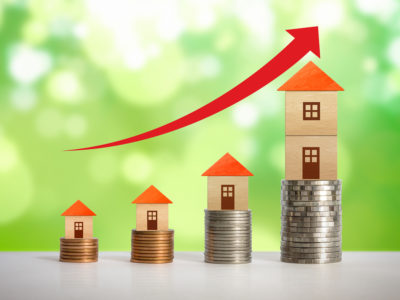
Many property holders and property buyers are unaware of capital gains and the calculation of capital gains taxwhile selling some property. Before understanding the capital gains tax on the sale of the property, let us first know the meaning of capital gains and some associated terms.
Define Capital Gains
To understand it clearly, let us put it simply, any gain or profit that has arisen from the sale of some ‘capital asset’ is termed as a capital gain. This profit or gain comes in the category of ‘income’ and therefore, one has to pay the taxes for that amount in the year where the transfer of capital asset takes place. This capital gains tax can be long-term or short-term.
The inherited property does not attract any capital gains because of no sale instead only ownership transfer occurs in it. As per the Income Tax Act, the assets received as a gift through inheritance or will are specifically exempted. However, if a person who has inherited the assets decides selling it, the capital gains tax is applicable.
Calculating Long-Term Capital Gains

Before understanding the calculation of long-term capital gains, we must know the terms associated with it:
- Cost of Acquisition: The value for which the seller has acquired the capital asset.
- Full Value Consideration: The consideration that the seller receives as a result of the transfer of his/her capital assets. Capital gains are charged to tax in the year when they are transferred, even if they have not received any consideration.
- Improvement Cost: Capital nature’s expenses incurred in making any alterations and additions to the capital asset by the seller. It is to be noted that all the improvements made before 01stApril’ 2001 are not taken into consideration.
Note: In some cases, where the capital asset becomes taxpayer’s property otherwise than through some outright purchase made by the taxpayer, the acquisition cost and improvement cost incurred by the owner (previous) is also included.
Steps for Calculating the Long-Term Capital Gains
The steps for calculating the long-term capital gains are as follows:
- Step 1:Start the process through consideration of full value.
- Step 2:Perform the following deductions:
- The expenditure incurred completely and exclusively with this transfer.
- Indexed improvement cost or cost of improvement
- Indexed acquisition cost or cost of acquisition
- Step 3:From the result, deduct the exemptions that are mentioned under Section 54EC, 54, 54B, and 54F.
Long-term capital gain = Full value consideration
Minus: Expenses incurred specifically for such transfer
Minus: Indexed cost of improvement
Minus: Indexed cost of acquisition
(*Sale proceed expenses from the capital asset, that directly and completely related to the transfer or sale of the capital asset are to be deducted. These expenses are compulsory for transfer)
According to the budget of 2018, long term capital gains upon the sale of units of equity oriented fund/ equity shares, realized after March 31st’ 2018 will keep exempted up to 1Lakh Rupees per year. In addition to this, tax at the rate 10%is levied only on long term capital gains on units/ shares of equity oriented fund that exceeds Rs.1 Lakh in a financial year without the indexing benefit.
In the event of sale of house property:
The following expenses are deducted from the complete sale price:
- Stamp papers cost
- Commission or brokerage paid to secure a purchaser
- Where the property is inherited, costs of the executor, obtaining a succession certificate can also be allowed in some cases.
- Traveling expenses in case of transfer – these expenses may incur after transfer.
In the event of sale of shares:
In this situation, one is allowed to deduct the following expenses:
- The commission of the broker related to sold shares.
- Security Transaction Tax or STT is not considered in the deductible expenses.
Indexed Cost of improvement/ Acquisition
These costs are indexed by applying the Cost Inflation Index (CII). This is done for adjusting the inflation over the time of asset holding. It improves the cost base of a property owner and lower downs the capital gains.
Calculation of Indexed Cost of Acquisition
The acquisition cost is calculated as – the cost of acquisition / CII for the year wherein the asset was initially held by the seller, or 2001-2002, whatever is later X CII for the year in which the asset is being transferred.
Indexed Cost of Improvement = Cost of acquisition * CII of the year wherein the asset is transferred /CII of the year wherein asset was initially held by the seller or 2001- 2002, whatever comes later.
Calculation of Indexed Cost of Improvement

Indexed Cost of Improvement = Cost of Improvement * CII of the year wherein the asset is being transferred / CII of the year wherein the improvement has taken place.
Example
Suppose a person ‘A’ has purchased a house in the year 2002 in Rs.15 Lakhs and he/she has sold it recently in Rs.60 Lakhs. How much tax ‘A’ has to pay in this case?
In this example it is clear that the person has possessed the property for more than two years, thus he/she gains a long-term capital gain by selling it. Here, the person ‘A’ has to index the cost of the improvement (if any made) and cost of acquisition made over these years. He/she can do the indexation through the multiplication of the cost of the property through Cost Inflation Index (CII) of the year wherein the property is sold and dividing it by CII of that year in which the property is sold and dividing it through the CII of the year in which the property was purchased.
Since the CII for the year 2019 – 20 is not yet announced. Therefore, to calculate the capital gain, person ‘A’ has to reduce the indexed acquisition cost from the property’s selling price. In this way, the capital gains taxwill be 20.8%. One can do the tax saving by investing the amount of sale in the purchase of a new house or buying some capital gains bonds.
The Bottom Line:
In this way, by understanding the terms and applying the above formula, one can easily calculate the long-term capital gains tax for selling a property.


